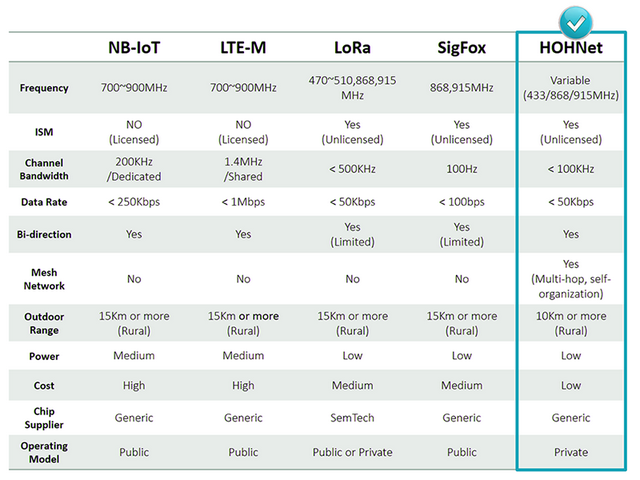HOHNet™ - The Wireless Sensor Network Protocol
Distributed interaction and exchange of the Internet of Things, just like the water molecule ("H2O" and "HOH"), permeating almost every aspect of our lives.

What is a Wireless Sensor Network (WSN)?
A wireless sensor network is a group of specialized transducers with a communications infrastructure for monitoring and recording conditions at diverse locations. Commonly monitored parameters are temperature, humidity, pressure, illumination, vibration & sound intensity, power-line voltage, air quality and so on.
WSNs can be seen as the basic constituents of IoT because they can help connect remote assets with the people who manage them, enabling real-time monitoring and management in difficult-to-access locations or where wired solutions are impractical or cost-prohibitive.
What is HOHNet™?
HOHNet™ is an easy-to-install, end-to-end WSN solution owned by WiiHey. It takes advantages of LPWAN (low-power wide-area network) and UNB-IoT (Ultra Narrow Band-IoT) radio technologies for wireless communication that can have superior performance to normal WSNs. Key features are quick setup, self organization, flexibility to expand, and low energy consumption.
The basic components in HOHNet™ are the sensor nodes and the gateway. The sensor nodes deployed distributedly acquire data and transmit data to the gateway. The gateway in turn transmits data to the cloud platform as depicted below:

The gateway can have several forms:
- The repeater: extends the range of the network by relaying incoming sensor data to the gateway. Compared to the gateway, a repeater is much small sized and low cost;
- The gateway: acts as the coordinator, bridging sensor data to the cloud platform. It is pass-through device that does not offer onboard storage or programmable capabilities;
- The edge gateway: collects, relays and has the capabilities to analyze data at the edge of network, to minimize consumption of network bandwidth and reduces system latency;
Normally, a gateway can access hundreds, even thousands of sensor nodes. Users can have multiple gateways in a WSN, each communicating in a different wireless channel, to achieve better network scalability.
Why HOHNet™?
WSN is a complex system, it involves various technologies from physical communication layer to application programming layer, that may include different types of sensors, different sampling modes, different vendors, different domains, and so on. So despite there are many WSN protocols and solutions to choose on the market, WiiHey developed its own WSN — HOHNet™ — to best meet our customers' IoT needs.
Additionally, there is always a gap between the information technology role (developers) and the operation technology role (users). Consider a monitoring demand on solar plant or parking spaces: for each individual target (a solar panel or a parking lot), users need to record the "pairing" relationship between a target and a sensor. So when users view sensor data online, they could know which target in the real world is referred to. But there could be hundreds or even thousands of solar panels or parking lots on the scene, how is possible to get all this information just by manual work?
Here comes HOHNet™, one of its biggest characteristics is self-organization that could really help smooth the deployment job. Here is its process:

As the figure shows, after sensor nodes have been placed to the positions, a sensor node broadcasts its status to the surroundings and receives status from other sensor nodes. Thus, they could detect each other and know the one-hop neighbors. Next, the sensor nodes are organized into a connected network according to a certain topology (linear, star, tree, mesh, etc.). Finally, suitable routing paths are computed on the constructed network for transmitting the sensing data.
Back to the above deployment topic, because the solar panels or the parking lots are always arranged in a sort of rectangle geometry layout and considering the fact that sensor nodes know their neighbors, HOHNet™ could use this information to create a sensor-to-target pairing map. Users only need to bind the relationship between the anchor sensor nodes (usually at boundary or vertexes of the layout) with the targets, and let HOHNet™ decides the rest parts of the network.
Features
- Range from 1 to 10 km in different environment conditions;
- A small portion of data transmitted with low throughput varying from few bit/sec to 50k bit/sec;
- High autonomy of smart devices with a long battery life;
- Inexpensive, large-scale, distributed sensor nodes;
- Scalable access points (repeaters, gateways) to cover wide area;
- Good penetration in case of using sub-GHz ISM radio bands;
- Self-organized, easy-to-deploy network with less configuration work;
Applications
- Environmental monitoring of air, water, and soil;
- Structural monitoring for buildings and bridges;
- Industrial machine monitoring;
- Process monitoring;
- Asset tracking;

